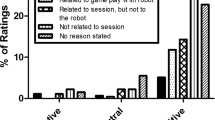Abstract
Acceptance is an important ergonomic matter for an effective use of technologies, especially in the case of assistive robots. Work on acceptance with children with autistic spectrum disorder, including their parents, is still lacking. Therefore, this study aims at evaluating robots’ acceptance with parents and children with and without autistic spectrum disorder. We proceeded by evaluating acceptance and anthropomorphism before and after a free interaction with the Pepper robot, for neurotypical children (N = 13) and children with autism (N = 5) and their parents. Preliminary results indicate that acceptance metrics showed a rather positive appreciation of the robot by the children but less positive for their parents. Limitations and recommendations are proposed at the end of the study.
E. Zehnder, M. Jouaiti—These authors contributed equally.
Access this chapter
Tax calculation will be finalised at checkout
Purchases are for personal use only
Similar content being viewed by others
References
van den Berk-Smeekens, I., et al.: Adherence and acceptability of a robot-assisted pivotal response treatment protocol for children with autism spectrum disorder. Sci. Rep. 10(1), 1–11 (2020)
Bishop, L., van Maris, A., Dogramadzi, S., Zook, N.: Social robots: the influence of human and robot characteristics on acceptance. Paladyn J. Behav. Robot. 10(1), 346–358 (2019)
Boccanfuso, L., Scarborough, S., Abramson, R.K., Hall, A.V., Wright, H.H., O’Kane, J.M.: A low-cost socially assistive robot and robot-assisted intervention for children with autism spectrum disorder: field trials and lessons learned. Autonom. Robots 41(3), 637–655 (2017)
Breazeal, C., Harris, P.L., DeSteno, D., Kory Westlund, J.M., Dickens, L., Jeong, S.: Young children treat robots as informants. Topics Cogn. Sci. 8(2), 481–491 (2016)
Davis, F.D.: Perceived usefulness, perceived ease of use, and user acceptance of information technology. MIS Q. 319–340 (1989)
De Graaf, M.M., Allouch, S.B.: Exploring influencing variables for the acceptance of social robots. Robot. Autonom. Syst. 61(12), 1476–1486 (2013)
Fridin, M., Angel, H., Azery, S.: Acceptance, interaction, and authority of educational robots: an ethnography study of child-robot interaction. In: IEEE Workshop on Advanced Robotics and Its Social Impacts, California (2011)
Fridin, M., Belokopytov, M.: Acceptance of socially assistive humanoid robot by preschool and elementary school teachers. Comput. Hum. Behav. 33, 23–31 (2014)
Goudey, A., Bonnin, G.: Must smart objects look human? study of the impact of anthropomorphism on the acceptance of companion robots. Recherche et Appl. en Mark. (Engl. Ed.) 31(2), 2–20 (2016)
Heerink, M., Kröse, B., Evers, V., Wielinga, B.: Assessing acceptance of assistive social agent technology by older adults: the almere model. Int. J. Soc. Robot. 2(4), 361–375 (2010)
Huijnen, C.A., Lexis, M.A., Jansens, R., de Witte, L.P.: Roles, strengths and challenges of using robots in interventions for children with autism spectrum disorder (ASD). J. Autism Dev. Disord. 49(1), 11–21 (2019)
Huskens, B., Palmen, A., Van der Werff, M., Lourens, T., Barakova, E.: Improving collaborative play between children with autism spectrum disorders and their siblings: the effectiveness of a robot-mediated intervention based on lego® therapy. J. Autism Dev. Disord. 45(11), 3746–3755 (2015)
Kory-Westlund, J.M., Breazeal, C.: Assessing children’s perceptions and acceptance of a social robot. In: Proceedings of the 18th ACM International Conference on Interaction Design and Children, pp. 38–50 (2019)
Kumazaki, H., et al.: A pilot study for robot appearance preferences among high-functioning individuals with autism spectrum disorder: implications for therapeutic use. PloS One 12(10), e0186581 (2017)
Lallemand, C., Gronier, G.: Méthodes de design UX: 30 méthodes fondamentales pour concevoir et évaluer les systèmes interactifs. Editions Eyrolles (2015)
Liu, B., Markopoulos, P., Tetteroo, D.: How anthropomorphism affects user acceptance of a robot trainer in physical rehabilitation. In: HEALTHINF, pp. 30–40 (2019)
Liu, K., Tao, D.: The roles of trust, personalization, loss of privacy, and anthropomorphism in public acceptance of smart healthcare services. Comput. Hum. Behav. 127, 107026 (2022)
Meuter, M.L., Bitner, M.J., Ostrom, A.L., Brown, S.W.: Choosing among alternative service delivery modes: an investigation of customer trial of self-service technologies. J. Mark. 69(2), 61–83 (2005)
Nomura, T., Shintani, T., Fujii, K., Hokabe, K.: Experimental investigation of relationships between anxiety, negative attitudes, and allowable distance of robots. In: Proceedings of the 2nd IASTED International Conference on Human Computer Interaction, Chamonix, France. ACTA Press, pp. 13–18. Citeseer (2007)
Oros, M., Nikolić, M., Borovac, B., Jerković, I.: Children’s preference of appearance and parents’ attitudes towards assistive robots. In: 2014 IEEE-RAS International Conference on Humanoid Robots, pp. 360–365. IEEE (2014)
Raub, A.C.: Correlates of Computer Anxiety in College Students (1981)
Ricks, D.J., Colton, M.B.: Trends and considerations in robot-assisted autism therapy. In: 2010 IEEE International Conference on Robotics and Automation (ICRA), pp. 4354–4359. IEEE (2010)
Thompson, D.V., Hamilton, R.W., Rust, R.T.: Feature fatigue: when product capabilities become too much of a good thing. J. Mark. Res. 42(4), 431–442 (2005)
Troshani, I., Rao Hill, S., Sherman, C., Arthur, D.: Do we trust in AI? role of anthropomorphism and intelligence. J. Comput. Inf. Syst. 61(5), 481–491 (2021)
Tung, F.W.: Child perception of humanoid robot appearance and behavior. Int. J. Hum.-Comput. Interact. 32(6), 493–502 (2016)
Venkatesh, V., Morris, M.G., Davis, G.B., Davis, F.D.: User acceptance of information technology: toward a unified view. MIS Q. 425–478 (2003)
Westlund, J.M.K., Martinez, M., Archie, M., Das, M., Breazeal, C.: Effects of framing a robot as a social agent or as a machine on children’s social behavior. In: 2016 25th IEEE International Symposium on Robot and Human Interactive Communication (RO-MAN), pp. 688–693. IEEE (2016)
Acknowledgements
We thank all the children and parents who willingly took part in this study and filled in so many questionnaires.
Author information
Authors and Affiliations
Corresponding author
Editor information
Editors and Affiliations
Rights and permissions
Copyright information
© 2022 The Author(s), under exclusive license to Springer Nature Switzerland AG
About this paper
Cite this paper
Zehnder, E., Jouaiti, M., Charpillet, F. (2022). Evaluating Robot Acceptance in Children with ASD and Their Parents. In: Cavallo, F., et al. Social Robotics. ICSR 2022. Lecture Notes in Computer Science(), vol 13818. Springer, Cham. https://doi.org/10.1007/978-3-031-24670-8_5
Download citation
DOI: https://doi.org/10.1007/978-3-031-24670-8_5
Published:
Publisher Name: Springer, Cham
Print ISBN: 978-3-031-24669-2
Online ISBN: 978-3-031-24670-8
eBook Packages: Computer ScienceComputer Science (R0)




